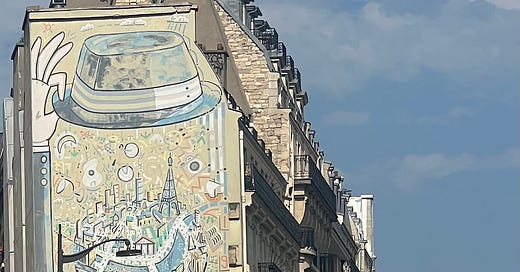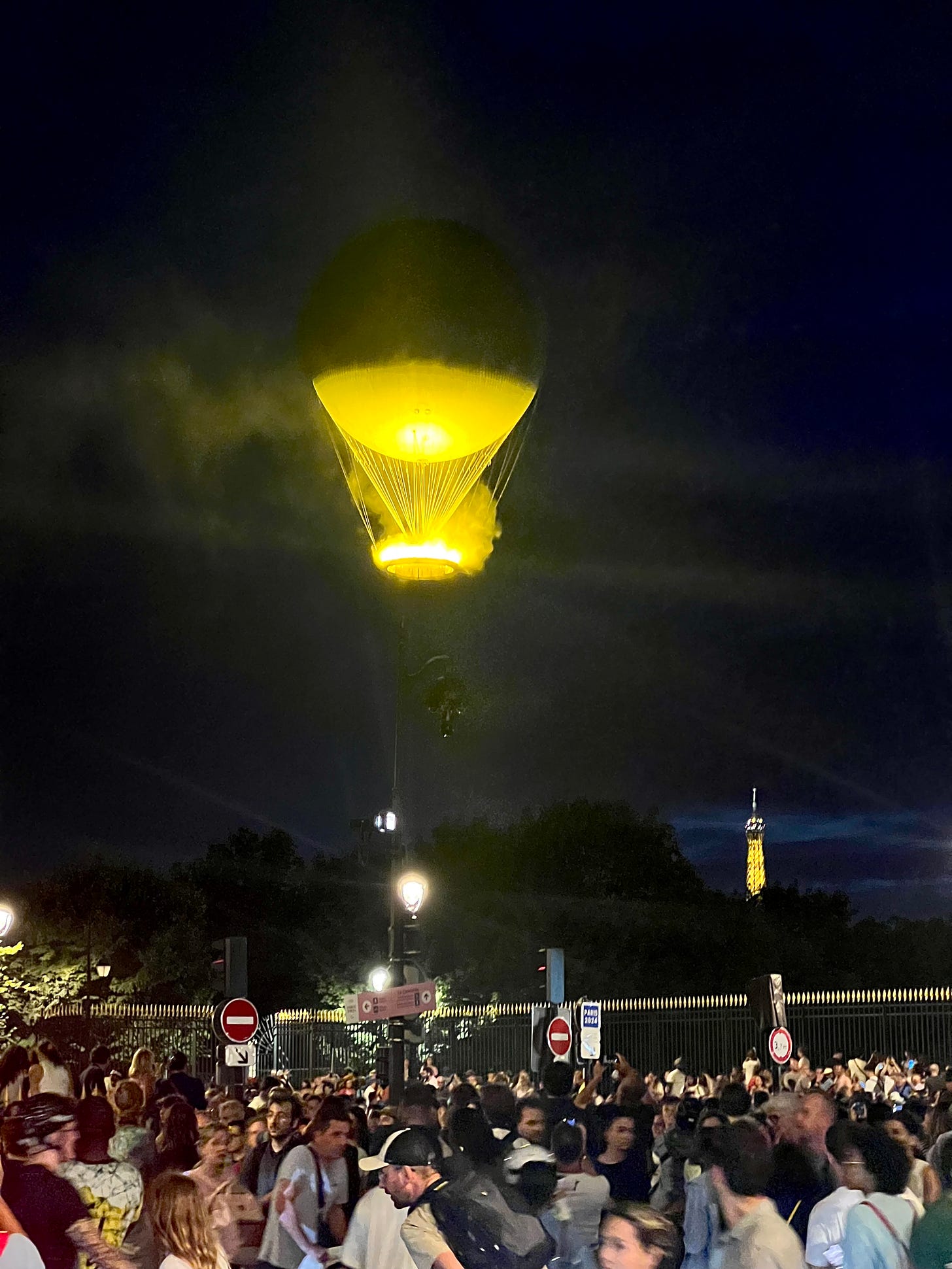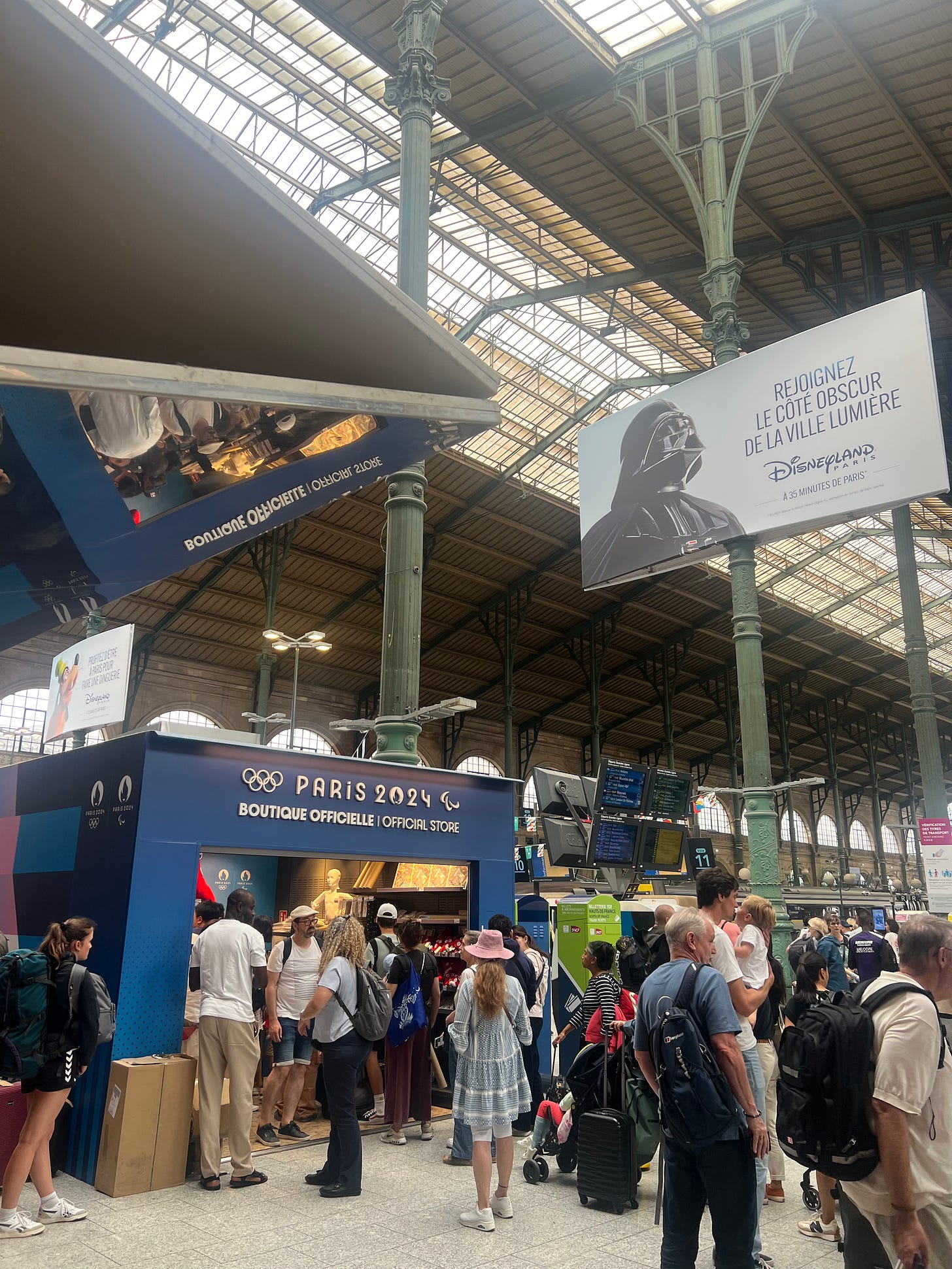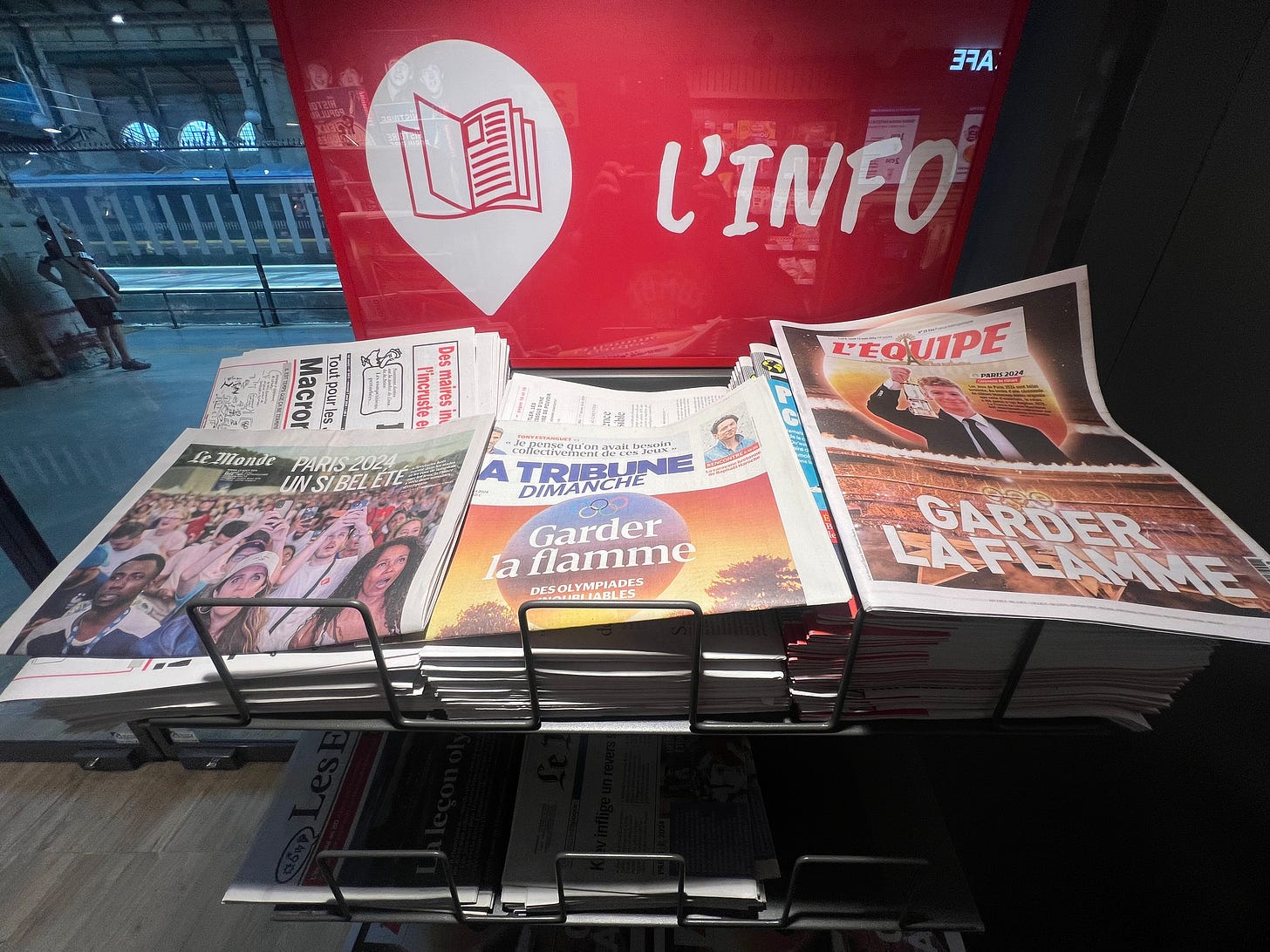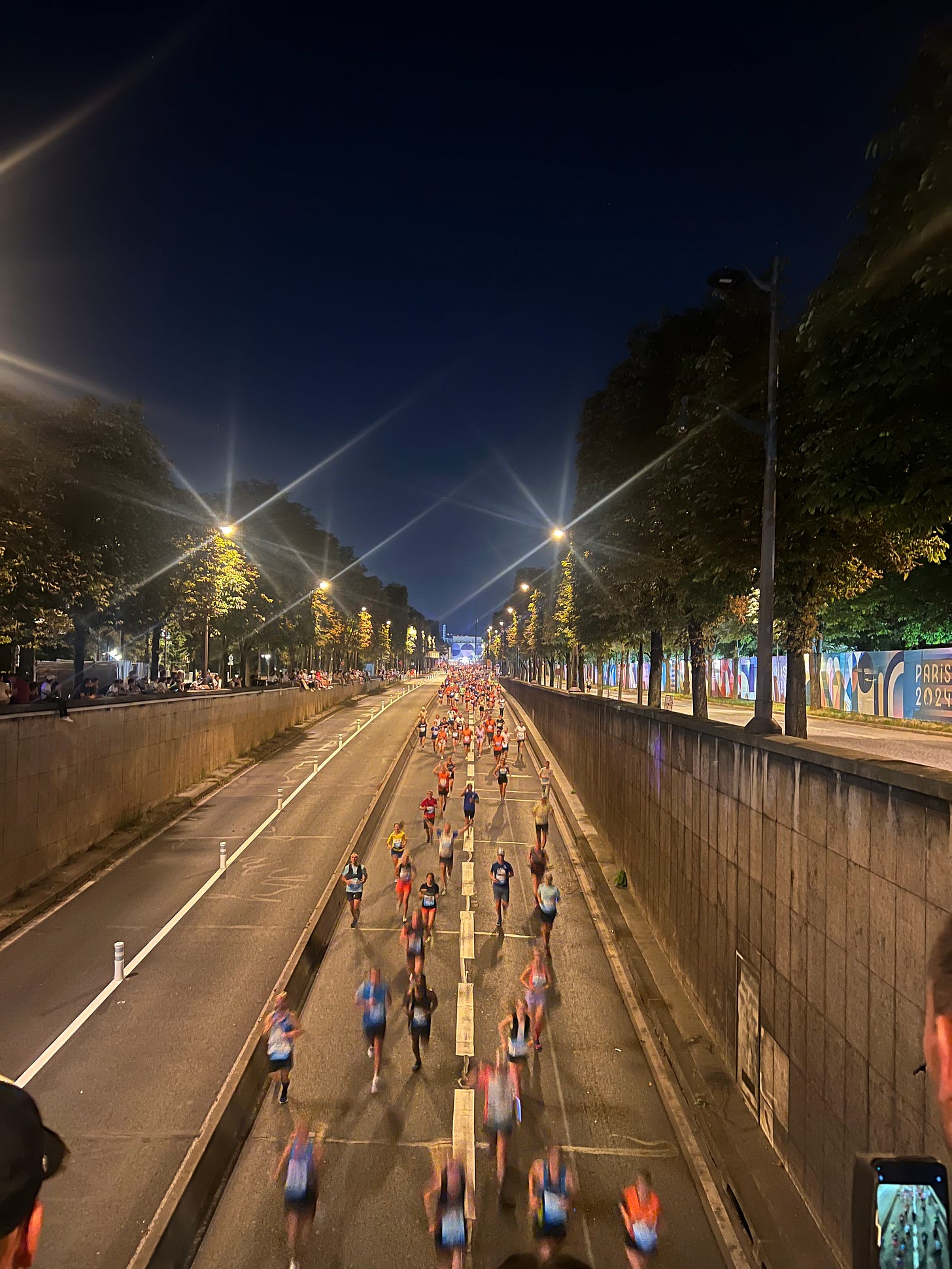An Olympic instant: glimpses of the Games in Paris
Paris 2024 revitalised the Olympic movement, while sparking new questions about its relationship with host cities. Outlines returns with a visit to the French capital.
Almost every street in Paris was what historians call a site of memory. And the longer I spent there, the more ghosts I sensed.
Simon Kuper, The Impossible City: Paris In The 21st Century
It was, they said, an Olympic Games 100 years in the making.
It was 16 days in the partaking.
I was there for about two and a half of those days – the last of them. By the time I arrived at Paris 2024, its reviews were three-quarters written. The validation of its success, barring some catastrophe, was a rubber-stamp and an elegant bow away.
There had been the odd glitch: a half-forgotten act of sabotage that caused rail chaos just before the curtain; a near-failure to clean the Seine in time for triathlon and marathon swimming; the grinding, angsty inconvenience of a massive security operation. But a mainstream opinion was becoming consensus: Paris had pulled it off.
There is something uncanny about gatecrashing an Olympic party, ticketless and unaccredited, right at the very end. Spending time out in the city itself, you can feel that the grooves are set. Protocol has become habit, and then ritual. The nerves have suffused into molten enthusiasm, soon to curdle into nostalgia.
Much of Paris, like my hometown 12 years ago, has surrendered its studied indifference and giddily embraced the occasion. There is official merchandise everywhere: not just in boutiques but on the back or the head of every second person you pass.
You think of Paris and all the versions of people who pass through it: the artists, writers, activists, artisans and professionals, the achingly earnest 18-year-old students who go on to cover the sports business. But the Olympic Games are an all-consuming moment in time. They move people and make memories in a brief and shuddering flash.
What will remain at the end, when all these apparitions of the hot high summer have disappeared?
Paris does things to people.
It can stir an aggressive strain of main character energy. And it has been heard to trigger a rare and distinct form of alienation – Paris syndrome – where starry-eyed visitors recoil from the mundane urban realities of dirt and disorder and bureaucratic dead ends.
You know Paris.
This is a remarkable, captivating, confounding kind of town. And as odd as it seems to say, Paris is everywhere at these Games. It envelopes the action.
Even the most successful hosts – London again – have historically built from the concept of a single park, an Olympic playground that draws in fans and radiates excitement. Here, instead, taking so many events to popular landmarks – through an array of indoor arenas and spaces like the Parc Urbain, by Place de la Concorde – has concentrated energy in the centre.
Let’s just be pretentious for a minute. Paris 2024 has nailed the mise-en-scène.
This was the thought behind the audacious, challenging and (almost) unapologetically French opening ceremony that gave its rain-lashed welcome to the world. Yet the actual Olympics have accomplished this more successfully, not just on screen but in person. Few sporting events on this scale can have so effectively captured a sense of place.
It has some funny, superficial effects. Every time you stop to take a picture, someone else is taking the same picture. Often, it’s a throng – a chain of repeated motion like an F1 pitlane or a wide shot on an Attenborough documentary.
But these are not just an Instagram Games. There is an experience as much as a spectacle. Late each evening, when that Jules Verne-style balloon-cauldron carries up the Olympic flame, the surrounding streets throb with onlookers emptied out of competition venues and local bars. The terraces of bistros, bars and brasseries, usually pointed outwards to survey the streets, now gather passers-by who peer in to catch the latest drama on TV.
On some level, it’s all just a stage – one cleared for the Olympic visitors by many of the same Parisians who flee every August for the relative cool of the country or the coast. But in the right moments, the fans themselves are standing on it.
There is an obvious shorthand at play.
The identity of Paris is often collapsed into that Hausmann-era 19th century core.
To be fair, not all of these Olympics have played out there. There are the standout exceptions: athletics in the banlieues at the Stade de France, swimming among the suits of La Défense, equestrianism amid the opulence of Versailles.
And there are attempts to activate the city away from the action itself. In the 19th arrondissement to the north-east, just inside the Boulevard Périphérique ring-road that broadly divides central Paris from its ever-expanding suburbs, lies La Villette – and for the duration of the Games, the Parc des Nations.
For many, La Villette will feel like another variation of Paris – away from familiar landmarks and references. Built in the 1980s, it is home to the Cité des Sciences et de l'Industrie, Europe’s largest science museum, along with an open-air cinema and geodesic dome. The whole thing projects a different set of cultural and technical ambitions. The atmosphere and activity by the adjacent canals are a bit reminiscent of London’s rebuilt Kings Cross.
Parc des Nations is a popular attraction on the scorching final Saturday of the Olympics. Several National Olympic Committees have set up shop here, their installations on a spectrum between fan zone and cultural shop window.
Thousands of spectators flock to Netherlands House and a sold-out Club France. Ukraine’s base raises awareness and funds for the war at home. At one point, half the park resounds to the strains of Naatu Naatu, the Oscar-winning song from last year’s Tollywood smash RRR, bouncing confidently from the giant India House facility on the water’s edge.
Still, it is possible to escape these Games.
While the latticework of the Eiffel Tower has been in photobombing overdrive, Notre-Dame cathedral – for reasons that hopefully remain obvious – has mostly been left out of the Olympic picture. The nearby Quartier Latin – home to the Sorbonne University and, during Paris’ last Games in 1924, Hemingway, Picasso, Gertrude Stein and co – is also appreciably quieter.
Seasonal factors are involved, but there could well be financial consequences in how annual tourist euros have been redirected.
Even with excitement at its peak, there is always a gap between the Olympic image of a city and its reality. Paris 2024 has often filled it pretty well. But the space between the biggest event in the world and those who do not care about it is also the space where the future of the Games will be contested.
Back in the Gare du Nord, above a queue for a merchandising kiosk, Darth Vader looms from a giant banner.
It’s an ad for Disneyland Paris, and it reads: ‘Join the dark side in the City of Light.’
There’s a joke to be made here about sinister imperial avatars, and Disney, and the IOC, and the history of countries in this part of Europe.
But it is also a reminder of how 2020s media is powered by the aggregation and amplification of IP: from franchised, synergised entertainment to the multiplication of audiences across different channels. The implications of this are very much apparent at Paris 2024.
Chief among them is a running dialogue about the role of brands within the arena: the Louis Vuitton medal cases and the Samsung-captured selfies on the podium leaking out a little from historic IOC marketing constraints. Then you have the steady trickle of influencer collaborations, and the winking omnipresence of Snoop Dogg.
Media and sponsorship rights are inevitably evolving in this direction. Maybe hosting rights will, too. Paris often appears less like a backdrop to these Olympics and more like a partner, in that somebody x something way these things are now described. The city is lending its brand to the IOC, and vice versa.
Los Angeles is sure to push this further in 2028. Its closing ceremony contribution is dripping in those signifiers: the Hollywood sign, trail-hiking and biking, an appearance of quite exceptional Tom Cruise-iness, even by his standards, from Tom Cruise. It may have irritated some inside the Stade de France but it was no accident that an all-star West Coast concert played from a sunblasted California beach, not under floodlights in St Denis.
Nestling within all of this is the perennial question of what is required of an Olympic host. Paris 2024, of course, was meant to be Paris 2012, before a surprise loss to its half-sibling rival across the Channel.
In that belle epoque of sports bidding, there was usually an emphasis on the transformative potential of sporting events – the long-term value generated by big upfront infrastructural spending. That thinking has faded for now.
Several practical advances have allowed Paris to build this specific Olympics: demountable venues, paperless ticketing, ever more effective remote production. Eurosport can cluster half a dozen TV studios on the same hotel rooftop; digital resales help fans remake their daily plans on the fly. Much of it, though, is informed by that wider shift in expectations.
So how durable is this as a way of framing the host city relationship? There is no single model for a summer Olympic venue right now. LA is a fundamentally different city from Paris. Brisbane 2032 promises a more regional concept. There is talk then of Mumbai, Riyadh, Istanbul or Jakarta, all raising wholly different conversations about budget, infrastructural scope, and plenty besides.
The headline success of Paris 2024 has been cause for relief, then admiration, then celebration – both for the city and the Olympic movement, rebuilding confidence after the protracted anxieties of Rio and the Covid-enforced sterility of Tokyo and Beijing.
The Thomas Bach era is ending at the International Olympic Committee but all the debates that have surrounded it – about mission creep, and politics, ageing audiences and control – will outlast it.
The Olympic Games are brilliant. They just are. But what exactly is that worth?
There’s a line by an Irishman who lived a fair while in Paris.
‘The past,’ wrote James Joyce, ‘is consumed in the present and the present is living only because it brings forth the future.’
Truly, the view of a man with a taste for a porous deadline.
Still, in some sense, major sports events do carry a whisper of that luxurious philosophy. The mission for Paris 2024, beyond the literal nuts and bolts and the trials of logistics, was to draw on the city’s nested heritage and confirm its relevance today and tomorrow.
The mood around these Olympics came very close to being very, very different. The challenges that face places like Paris – politically, economically and climactically – are not to be solved by a few weeks of elite sporting competition.
So what future can all this bring forth?
The long-serving mayor of Paris, Anne Hidalgo, has a complicated legacy. Her popularity is fragile; a 2022 run for the national presidency was more Connor Roy than Charles de Gaulle. But nobody could accuse her of lacking commitment to a vision, or of ignoring the longer-term horizon.
The imprint of the Hidalgo project was visible in an Olympics that trended towards fewer cars, more public transport, and much more personal mobility. Bike lanes were busy; pedometers pushed to their limits through famously walkable streets.
And for all the indelible romance of the surroundings, and the quality of the sport, some of the most consequential images that Paris 2024 leaves behind might lie in that invitation to physical activity.
A late-night public marathon and 10k run proved a ‘why has no one thought of this’ kind of hit: thousands of runners cheered on into the early morning, jittery walks past Saturday night crowds forgotten in their shared moment of Olympic history.
The €1.4 billion plan to restore and race in the Seine tiptoed more than once to the brink of fiasco. But it could shape the future of a city that gets extremely hot in the summertime and is not getting any cooler any time soon. Paris, incidentally, is not alone in asking how open-water spaces will feature in lives of its citizens.
These are glimpses of a near future that will be challenging and fascinating for any city, Olympic or not.
As it looks out to the Paralympics and beyond, Paris will restate goals outside those tourist signatures – championing the energy and entrepreneurialism that bring life to those old façades, and the communities that give them meaning. This is a place for people to live in, work in and invest in. Globally, the competition for talent and ideas is intense.
The Olympics is the easy part.
For now, this is a place that people are leaving. The first sign of exodus comes early on Sunday morning, not long before the women’s marathon begins: the trail of backpacks and roller suitcases towards trains and planes, halted only by coffee and pains au chocolat.
A day later, in spots, it feels like all those visitors have evaporated. There are crowds to be found but the GPS data tells its own story: not too busy, not too busy, less busy than usual. These Games have gone in an instant.
Paris is bleached and sweating under a cloudless sky. You blink through the sunlight, as the sprites still flicker before your eyes.
Eoin Connolly is a writer, editor and presenter. He is also the founder of 26 Forty, providing original storytelling and editorial services for the sports industry.

